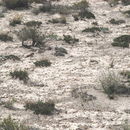mk
имиња во трошки


Pygmy sagebrush grows in specific, limited habitats [26] and is a component of communities with rare
plant species [56]. It occurs primarily in desert grassland, salt
desert shrub, pinyon-juniper (Pinus-Juniperus spp.), and interior ponderosa pine (Pinus ponderosa
var. scopulorum) communities of the Great Basin and Uinta Basin [56].
In Utah, pygmy sagebrush occurs in black
sagebrush (Artemisia nova) [6,16,31,32,33,56], rabbitbrush (Chrysothamnus spp.), shadscale
(Atriplex confertifolia), greasebush (Glossopetalon spp.),
juniper, pinyon-juniper, and ponderosa pine communities [56].
Pygmy sagebrush is a dwarf, cushionlike,
evergreen, perennial native shrub. This desert species exhibits numerous
morphological adaptations that enable it to live in very xeric sites. It grows
no taller than 8 inches (20 cm). Leaves on the vegetative stems are
nearly glabrous, between 0.08 to 0.16 inch (2-4 mm) wide, 0.08 to 0.32 inch (2-8 mm) long, and are pinnatifid
with 3 to 11 lobes, or sometimes may be only toothed [8,18,56]. Leaves on the flowering branches are usually
reduced and may be entire [6,27,31,32,33]. The flower head contains 3 to 5 disc flowers arranged into spikelike
inflorescences. Ray flowers are lacking. Fruits are glabrous or
resinous-glandular achenes
[8,56]. Seeds are large for Artemisia species [6,27];
however, quantitative seed measurements are not available. Pygmy
sagebrush has a taproot [56].
Artemisia pygmaea is a North American species of sagebrush in the aster family known by the common name pygmy sagebrush.[2]
Artemisia pygmaea is a small, cushion-like shrub growing up to about 20 centimeters (8 inches) in height. It is woody and grows from a taproot.[2]
The small leaves are under a centimeter long and wide and are toothed or divided into several deep lobes.[2]
The flower heads contain 3 to 5 disc florets but no ray florets. It is dioecious, with male and female flowers occurring on separate individual plants.[3] Blooming occurs in August and September.[4][2]
This is one of several plants parasitized by the parasitic plant Orobanche fasciculata.[5]
Artemisia pygmaea is native to regions of the Southwestern United States, encompassing parts of Nevada, Utah, Colorado, Arizona, and New Mexico.[6] It is uncommon throughout much of its range but it can be locally abundant.[3][2]
Artemisia pygmaea grows in very dry habitat types. It occurs in the desert grasslands, pinyon-juniper woodlands, and playas of the American southwest, especially in the Great Basin and Uinta Basin. It favors calcareous soils such as gypsum, and alkali soils, salty soils, and clay. It tolerates substrates in which few other plants will grow. Its small size is an adaptation to its dry habitat.[3][7]
Artemisia pygmaea is a North American species of sagebrush in the aster family known by the common name pygmy sagebrush.
Artemisia pygmaea là một loài thực vật có hoa trong họ Cúc. Loài này được A.Gray mô tả khoa học đầu tiên năm 1886.[1]
Artemisia pygmaea là một loài thực vật có hoa trong họ Cúc. Loài này được A.Gray mô tả khoa học đầu tiên năm 1886.